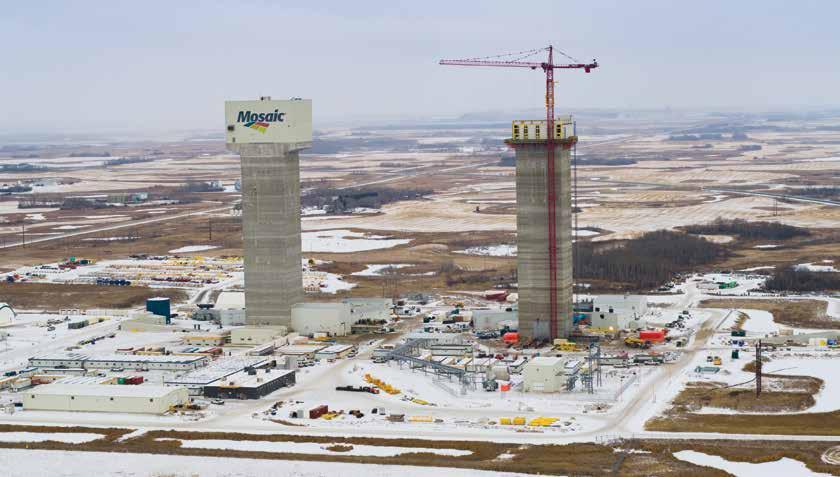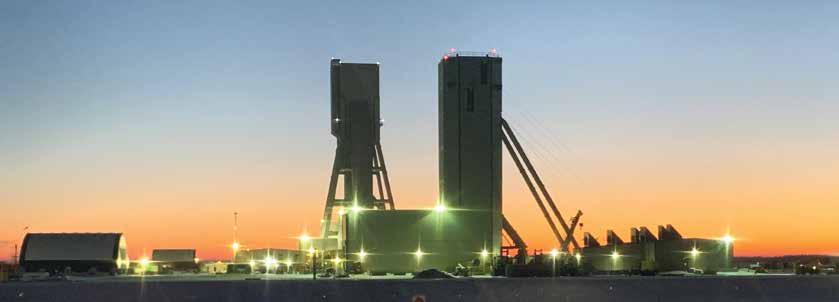
8 minute read
Looking back at 2020: A year in the potash industry
LOOkinG BACK AT 2020
a Year IN tHe pOTaSh induSTry
By stEvE haLaBura P.gEO., haLaBura POtash COnsuLtIng LtD.
“Potash” is a generic term describing various forms of potassium-bearing fertilizer products. the most common of these products is “Muriate of Potash” or “MoP”, which is potassium chloride (kCl) in a high-grade form. MoP provides the potassium macronutrient in the formulation referred to as N-P-k, or Nitrogen-PhosphorusPotassium. MoP is the product that will be referred to in this article.
the potash business in 2020 was largely stable, however lacklustre from the producers’ and investors’ viewpoint of enjoying significant price gains. While there were complications caused by infrastructure and logistics difficulties induced by the CoVID-19 pandemic, global demand remained generally strong, although there were regional differences in potash sales. the effect upon potash caused by the CoVID-19 pandemic was the same as for other bulk commodities, as lockdowns and reduced staffing created slowdowns in transportation and distribution. as for positive developments, there were more recognition by analysts and the investment community that potash is indeed a unique business. In the words of bHP billiton,
Mosaic’s new K3 Esterhazy mine is now in production, and while it will for the near-term replace production decreases from the older K2 and K1 mines, it does have the ability to increase production to meet any supply-demand imbalance, and by 2024 be ready to completely replace the older, high-cost mines. PHOTO BY THE MOSAIC COMPANY. potash is a “forward-facing” commodity, whereby the trend toward increasing awareness as to environmental responsibility and engagement with local communities and stakeholders bolstered, rather than degraded the business.

2020 was very much a year like 2019, with prices overall down slightly from the start of Q1. the global price opened with contracts in the UsD$220 to UsD$235 per tonne range, with Canpotex China contract prices currently at UsD$230 per tonne. for North american markets, potash opened
While there were complications caused by infrastructure and logistics difficulties induced by the COVID-19 pandemic, global demand remained generally strong, although there were regional differences in potash sales. PHOTO BY THE MOSAIC COMPANY. In its forecast to 2022, the Food and Agriculture Organization of the United Nations (FAO) reports that world supply of potash will grow from 52.7 million tonnes in 2020 to 54.2 million tonnes in 2022. PHOTO BY THE MOSAIC COMPANY.


the year at UsD$375 per tonne, and by the end of september it was UsD$338.
In asia, low palm oil prices led to weak demand from southeast asian potash purchasers. In europe, political tension in belarus over the summer caused some supply difficulties, however the fall fertilizer season was normal. China and India markets also remained largely flat, with local disruptions due to CoVID protocols. However, North america enjoyed a better-than-average crop year, leading to increased demand, and a drawdown of inventories, so while prices were down, increased sales volumes led to better financial performance by the big producers such as Nutrien and Mosaic.
overall, world demand remained strong in 2020. In its forecast to 2022, the food and agriculture organization of the United Nations (fao) reports that world supply of potash will grow from 52.7 million tonnes in 2020 to 54.2 million tonnes in 2022, while demand will grow from 38.7 million tonnes in 2020 to 40.2 million tonnes in 2022, which suggests an even supply/demand balance in the nearterm. Global production capacity is forecast to grow from 63.5 million tonnes in 2020 to 64.6 million tonnes in 2022, which is an increase of 1.1 million tonnes. Given forecasts of continued strong demand into 2021, and with no new significant supply anticipated for the year, forecast prices are closer to UsD$275 to UsD$285. Nevertheless, one must be careful not to be too bullish when forecasting future supply, as there are several factors that could affect this balance. Mosaic’s new k3 esterhazy mine is now in production, and while it will for the near-term replace production decreases from the older k2 and k1 mines, it does have the ability to increase production to meet any supply-demand imbalance, and by 2024 be ready to completely replace the older, high-cost mines. the same can be said for saskatchewan’s k+s bethune mine and Nutrien’s mining operations, all of which are capable of production expansion should there be a strong need for more potash supply. It is not yet time to expect a return to the years 2000 to 2005, where a significant disconnect between potash demand and supply led to the “Great Potash boom” and wild price appreciations.
In Canada, bHP billiton Canada Inc. (bHP) continued to delay its decision to commit its intended investment into the Jansen project, pushing back its decision deadline from february to mid-year 2021. the amount of the investment to finish Phase 1 of the mine is UsD$5.3 to $5.7 billion, with construction expected to take five years. overall, its intended investment into the Jansen project is some UsD$17 billion. bHP claims Jansen will be able to produce at around UsD$100 per tonne. full expansion of the project would require an additional three phases with each phase costing some UsD$4 billion each, thus creating a “monster mine” capable of producing some 16 million tonnes of potash per year.
expansion plans for global, new potash capacity remained slow in 2020, in part due to continuing capacity surpluses. raising the capital required to build large (three Mtpy) mining and production facilities remains a challenge, with the global situation in 2020 doing nothing to ease investor tensions. trade tensions between the Us and China have not only affected trade, but also impeded in the funds transfers that allow China to make investments overseas. Until these concerns are eased, numerous large projects will remain stalled well into 2021.
In 2020 the need for food security was brought into full view of the average consumer by disruptions to the food supply chain caused by the CoVID pandemic. this was not simply a function of availability, quality, and affordability, but also of timely production and delivery of consumer food products. on a local level, we can all remember empty shelves in super-
Full expansion of the Jansen Potash Project would require an additional three phases with each phase costing some USD$4 billion each, thus creating a “monster mine” capable of producing some 16 million tonnes of potash per year. PHOTO COURTESY OF BHP.

markets this spring, including shortages of basic staples like flour and toilet paper. While on the global level fertilizers are impacted by increasing world population, decreasing arable land base, and a decrease in available cultivated acreage due to changes brought about by climate shifts, on a local level, supply chain disruptions caused by shuttered production plants, increased logistical burdens, and imbalances between producers and processors all contribute to the “empty shelf” problem.
the above challenges affecting the big mine sub-sector also affected the small mine sub-sector. by small mine sub-sector, I mean those junior resource companies that are seeking new and innovative methods to mine potash and implement a business model that uses smaller, modular mine and production facilities to make an MoP product that is sold to a specific end-user who may or may not be a co-owner of the facility.
In Canada, progress by the smaller greenfield projects was focused upon organizing financing for specific projects. the most promising new technical development was announced by Western Potash Corp. (Western), that began the “active” phase of mining in 2020. Initial work was reported to be the construction of a sump using “cold” mining, which was then followed by “hot” selective mining. No news has been released by the company as to the status of the project, or whether successful selective solution mining was achieved.
as for the other small mine greenfield projects, including Gensource Potash (tugaske Project), CanPacific Potash (CanPacific), encanto Potash Corp. (Muskowekwan Project), Yancoal Canada (southey Project), karnalyte resources Inc. (Wynyard Project), Canada Potash Corp. (kirin Project), and Canada Golden fortune Potash Corp. (broadview Project), all continued work focused on enhancing the feasibility of their projects while exploring options for financing.
one glimmer of hope for finding new sources of capital by this sub-sector is in part driven by the recognition by larger institutional investors of the importance of food security, and in part by the demise of investments into the oil and gas and cannabis sectors. there is pent-up demand by firms to place capital, and fertilizers
BHP Billiton Canada Inc. (BHP) continued to delay its decision to commit its intended investment into the Jansen project, pushing back its decision deadline from February to mid-year 2021. PHOTO COURTESY OF BHP.

remain one of the few bright spots. the financial sector has not yet fully grasped the potential opportunity; however, 2021 may be an increase of capital placed into more advanced small mine sub-sector projects, including the division of greenfield big mine projects into a small mine and a big mine component.
as at the close of 2019, 2020 will exit largely as a year that showed nothing dramatic other than continued recognition by all players in the industry of that one unchanging, unarguable demand driver: population growth. It is beyond cliché to state the obvious that the eight-billion people to be on the planet by 2050 expect to be fed, and with climate change decreasing the amount of arable land, this will increase demand for fertilizer. However, for the investor, this is cold comfort – the potash business is notorious for the inability of producers to set their own prices, so to be profitable, successful companies must continue their focus on reducing operating cost per tonne by means of constantly evolving technology, streamlining the production and logistics chain, and supporting only the most efficient operations. s











